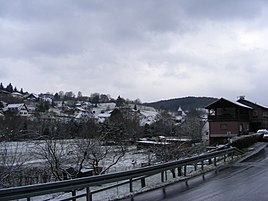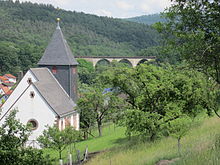Jossa (Sinntal)
|
Jossa
community Sinntal
Coordinates: 50 ° 14 ′ 17 " N , 9 ° 35 ′ 34" E
|
|
|---|---|
| Height : | 216 m above sea level NHN |
| Area : | 1.81 km² |
| Residents : | 670 (December 31, 2016) |
| Population density : | 370 inhabitants / km² |
| Incorporation : | July 1, 1974 |
| Postal code : | 36391 |
| Area code : | 06665 |
|
View of Jossa
|
|
Jossa is a district of the Sinntal community in the Main-Kinzig district in eastern Hesse . Jossa is located in the Spessart Nature Park and is a state-approved resort . The village has 639 inhabitants (as of June 30, 2014) and an area of 181 ha . Günter Walther was the long-time mayor (from 1997 to 2016). He was succeeded on April 26, 2016 by his son Stefan Walther.
geography
The river Jossa , which rises in the Spessart in Lettgenbrunn, flows into the Sinn east of the village . In this area there is also the nature reserve "Schachblumenwiesen" in which the protected chess flower (Fritillaria meleagris) thrives. The valley of the sense forms the border between the low mountain ranges Spessart and Rhön. The southern boundary of Jossa is also the border between the federal states of Hesse and Bavaria ( Lower Franconia ).
The townscape is characterized by a large railway viaduct on the old north-south route between Fulda and Würzburg . In some cases, freight trains on the Frankfurt – Würzburg route also run via Jossa.
history
In 1698 a Joßmüller was mentioned for the first time in the area of today's town , who initially owned a grain mill and later also a wood cutting mill on the Jossa. His house was probably the first house in Jossa. The actual village was laid out between 1725 and 1730 by residents of Breunings and Burgjoss and was named as Jossa as early as 1734 .
Parish Jossa belonged to the parish of Neuengronau , where the place is managed individually from 1760. The church in Altengronau was responsible , where the responsible elementary school was also located. From 1740 Jossa had his first teacher, Kaspar Buchhold. Because there was no school building yet, he moved from house to house with his students in the village. The first schoolhouse was built in 1797 in the town center. After a few decades, however, this was already too small and was replaced by a new, large school building in Küppelweg in 1847. Because the church did not have its own until 1910, a prayer room was also housed in this building. On top of the building there was a small bell tower with a bell.
In 1895, Jossa broke away from the Neuengronau parish and joined the Marjoss parish as a subsidiary parish . In 1909 the construction of a separate church began, which was consecrated in 1910. Due to the increase in the number of inhabitants, a new school building with two classrooms had to be built, which was occupied in the penultimate year of the war, 1944. In 1952 a third classroom was built opposite the main building, which is now integrated into the local fire station as a training room . A gym, which is also used for social and cultural events, was built in 1962. The school in Jossa has been closed since 2013. The primary school students visit the Hans Elm School in the neighboring village of Altengronau. The economic development of the place was particularly favorably influenced at the end of the 19th and the first decades of the 20th century by the railway construction Gemünden-Fulda and Jossa-Bad Brückenau-Wildflecken. The first holiday guests also came to Jossa by train in the 1950s, especially since express trains also stopped here.
Territorial reform
1 July 1974 at Jossa was in the course of administrative reform in Hesse powerful state law in the previously newly formed municipality of Sinntal incorporated . For Jossa, as for the other districts, a local district with a local advisory board and local councilor was formed.
population
Population development
Source: Historical local dictionary
| • 1747: | 19 households |
| • 1812: | 25 fireplaces, 394 souls |
| Jossa: Population from 1812 to 2017 | ||||
|---|---|---|---|---|
| year | Residents | |||
| 1812 | 394 | |||
| 1834 | 372 | |||
| 1840 | 391 | |||
| 1846 | 402 | |||
| 1852 | 707 | |||
| 1858 | 398 | |||
| 1864 | 413 | |||
| 1871 | 534 | |||
| 1875 | 425 | |||
| 1885 | 461 | |||
| 1895 | 435 | |||
| 1905 | 518 | |||
| 1910 | 598 | |||
| 1925 | 598 | |||
| 1939 | 647 | |||
| 1946 | 901 | |||
| 1950 | 891 | |||
| 1956 | 765 | |||
| 1961 | 743 | |||
| 1967 | 745 | |||
| 1970 | 734 | |||
| 1979 | 738 | |||
| 1990 | 717 | |||
| 1995 | 746 | |||
| 2000 | 691 | |||
| 2005 | 664 | |||
| 2010 | 655 | |||
| 2015 | 641 | |||
| 2017 | 627 | |||
| Data source: Historical municipality register for Hesse: The population of the municipalities from 1834 to 1967. Wiesbaden: Hessisches Statistisches Landesamt, 1968. Further sources:; after 1970: Sinntal community | ||||
Religious affiliation
Source: Historical local dictionary
| • 1885: | 421 Protestant (= 97.23%), 12 Catholic (= 2.77%) residents |
| • 1961: | 683 Protestant (= 91.92%), 58 Catholic (= 7.81%) residents |
Regular events
- Annual theater performances by the amateur drama group in the multi-purpose hall
- Choir concert with guest choirs
- Christmas market with wind choir, choir singing and children's Christmas games
Economy and Infrastructure
Public transport

The Jossa Station is located on the railway line Flieden-Gemünden . Regional trains run here on the Schlüchtern – Würzburg – Bamberg route , some of which also start or end in Jossa. The Jossa – Wildflecken railway branched from the station to Bad Brückenau and on to Wildflecken , on which all traffic has been suspended since March 31, 2005. The route has since been officially closed. However, there is a bus connection. The high-speed line Hanover – Würzburg runs east of the Jossa district largely in the Altengronauer Forst tunnel .
Road traffic
The place is a little more than 20 km away from the motorway junctions of the A 66 (Bad Soden-Salmünster or Steinau) and the A 7 (Bad Brückenau).
tourism
The location, which has won several awards in the competition “ Our village should be more beautiful ”, has ten circular hiking trails of various lengths. The 25 km long “Perlen der Jossa” cultural cycle path leads from Jossa in the Spessart to Villbach . Connection is via the long- distance cycle route R2 through the valley of the sense to both Mainfranken and the Rhön. Other plants are:
- Leisure facility in the Talaue with Kneipp facility,
- Playground and sports field with training and main fields
- versatile play area (prepared as an ice surface in winter)
- Fishing opportunities and observation of the local beavers
- Barbecue area with shelter
- Wellness oasis in a local hotel
education
- Hans-Elm-Schule in the neighboring village of Sinntal-Altengronau, 2 km away (elementary, secondary and secondary school)
- High school and technical schools in Schlüchtern (23 km - easily accessible by public transport)
Web links
- Jossa district on the website of the Sinntal community.
- Jossa. Local history, information. In: www.Jossa-Spessart.de. Verkehrs- und Heimatverein Jossa e. V.
- Jossa, Main-Kinzig district. Historical local dictionary for Hessen. In: Landesgeschichtliches Informationssystem Hessen (LAGIS).
- Literature about Jossa in the Hessian Bibliography
Individual evidence
- ↑ a b "Inhabitants, dates and directions". (No longer available online.) In: Internet presence. Sinntal community, archived from the original ; accessed in June 2018 . (Data from web archive).
- ↑ Sinntal community with districts (pdf) ( Memento from September 27, 2007 in the Internet Archive )
- ↑ Law on the reorganization of the districts of Gelnhausen, Hanau and Schlüchtern and the city of Hanau as well as the recirculation of the cities of Fulda, Hanau and Marburg (Lahn) concerning questions (GVBl. 330-26) of March 12, 1974 . In: The Hessian Minister of the Interior (ed.): Law and Ordinance Gazette for the State of Hesse . 1974 No. 9 , p. 149 , § 15 ( online at the information system of the Hessian state parliament [PDF; 3.0 MB ]).
- ^ Federal Statistical Office (ed.): Historical municipality directory for the Federal Republic of Germany. Name, border and key number changes in municipalities, counties and administrative districts from May 27, 1970 to December 31, 1982 . W. Kohlhammer, Stuttgart / Mainz 1983, ISBN 3-17-003263-1 , p. 377 .
- ↑ main statute. (PDF; 529 kB) §; 5. In: Website. Sinntal community, accessed February 2019 .
- ↑ a b c Jossa, Main-Kinzig district. Historical local dictionary for Hessen. (As of May 25, 2018). In: Landesgeschichtliches Informationssystem Hessen (LAGIS).
- ↑ Budget statute for the 2019 budget (PDF; 2.8 MB) Statistical information. (No longer available online.) Sinntal community, p. 41 , archived from the original ; accessed in January 2019 .



